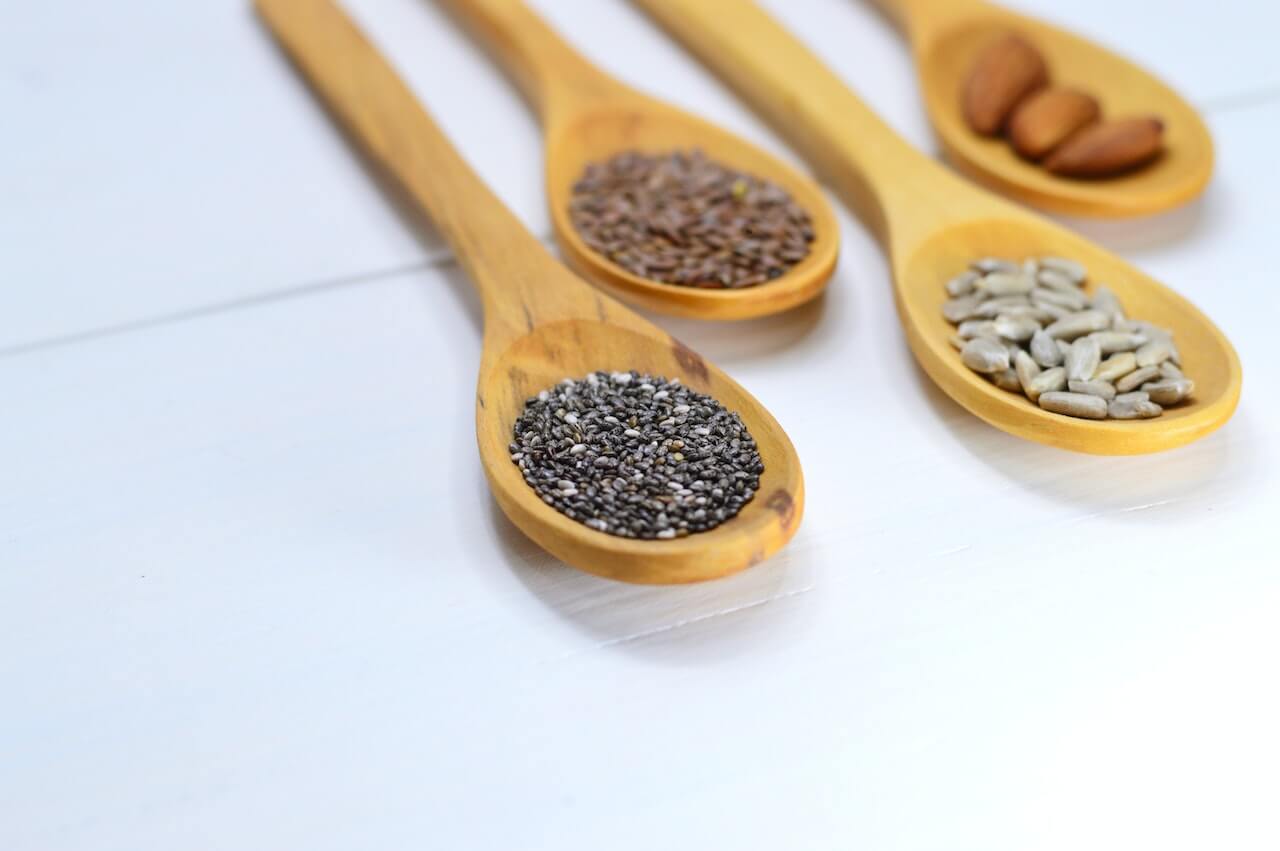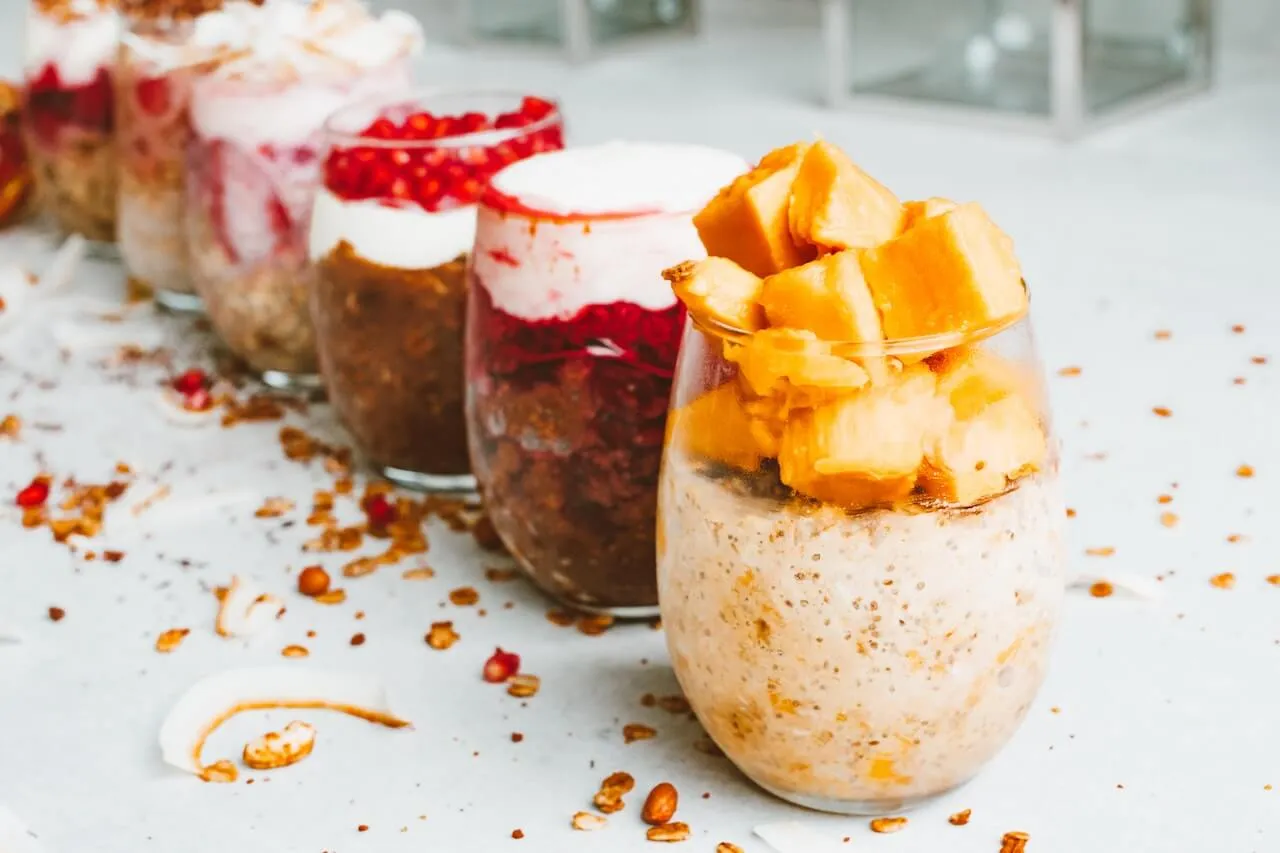Busy mornings call for a quick, easy-to-make, filling, nutritious breakfast. Protein shakes check all those boxes and then some. You can make them ahead of time and use a variety of food in your fridge. They are portable and are usually packed full of nutrition.
In this article, we’ll look at the benefits of having a protein shake for breakfast, some things to be mindful of, and how to make a healthy protein shake at home.
{{mid-cta}}
Benefits of Protein Shakes
A protein shake, often called a high-protein smoothie, is a delicious and easy breakfast that is satiating and can be a good way to kick-start your day.
They are easy to make and pack in a lot of nutrition, help you meet your protein intake goals, and start your day on the right foot.
Convenient and Easy
Protein shakes are an easy breakfast recipe that can be made in about 5 minutes. You can also whip one up the night before. All you need is some regular or plant-based milk, protein powder, an assortment of fruit and or vegetables, and a high-powered blender.
Packed With Nutrition
In addition to protein, these powerful breakfast shakes can be packed full of nutrition because of all the goodies you add.
Frozen fruit, leafy greens, chia seeds, oatmeal, nuts, and seeds contain high-quality nutrients. They provide healthy fats, antioxidants, and other important macronutrients.
Regular or plant-based milk adds calcium, potassium, and vitamin D.
A hearty protein shake with various ingredients can deliver a powerful nutrient boost to start your day.
Keep You Full/They Are Satiating
Protein is satiating, and a shake with protein powder and fiber will keep you feeling full all morning. Research has shown that a high-protein breakfast keeps you full longer and may help with weight loss.1, 2 It also helps keep your blood sugar more stable throughout the day.3
Helps With Meal Planning
Figuring out what to eat is one of the hardest parts of sticking to a healthy diet. Breakfast can be especially difficult when you are short on time. Protein shakes are an easy way to ensure your breakfast is a no-brainer.
Keep various fruits and veggies on hand and whip up a few shakes early in the week so you can grab one and go in the morning—no need to think about it or be tempted at the local coffee shop. Your nutritious and filling breakfast is ready to go.
Boost Metabolism
Protein is an essential nutrient for lean body mass, and it helps boost metabolism. A high-protein diet has been shown to increase metabolic rate, leading to more calories burned throughout the day.4
Additionally, protein shakes can be a great post-workout snack to help repair and build muscle after exercise. The combination of protein and carbohydrates in a shake makes for an ideal recovery drink.
May Help Lower Cholesterol
Replacing a high-fat breakfast with a protein shake could help lower your cholesterol levels. High-fiber smoothies containing extra nutrients like avocado, nuts, and protein powder can help reduce LDL (bad) cholesterol levels. Fruits and vegetables are also rich in antioxidants and other heart-healthy nutrients that can improve overall heart health.5
Bumps up Protein Intake in the Morning
If you're having trouble reaching your daily protein goals, starting your day by drinking protein shakes can help. Some people struggle to get enough protein in their diets, especially at breakfast time when they may opt for carb-heavy options like pancakes or bagels. Including a protein shake in your morning routine can ensure you are starting with a healthy breakfast.
Help With Weight Loss
As mentioned above, protein keeps you full and satisfied, making it an excellent choice for those trying to lose body weight. When paired with a healthy diet and regular exercise, protein shakes can aid in weight loss efforts by reducing cravings, supporting lean body mass, and helping you stay on track.6
Downsides to Consider
While protein shakes are great for a quick breakfast and are packed full of healthy nutrients, there are some things to be mindful of.
- Sweeteners: Store-bought or packaged shakes or smoothies may add a lot of sugar or artificial sweeteners. Some of the protein powders available also have added sweeteners. Read the ingredient label and look for “added sugars” on the nutrition panel to know what you're buying.
- High Calorie: Like added sweeteners, some protein powders or liquids may contain extra fat. Vegetable oils and fat are often added to make the shake creamy and rich tasting, but they can add a lot of calories. Again, read the label of any powder or protein supplement you use.
- Added Fiber: Some powders add psyllium, inulin (chicory root), or other fibers. While getting extra fiber in is great, be aware that these may cause some people GI distress, including gas and bloating.
One last thing to remember is that protein shakes are great for breakfast or a snack, but keep them to once a day. You should aim for a variety of nutrients throughout the day and week. This helps you meet all your nutritional needs. A varied diet is the best way to do this.
Protein Shakes for Weight Loss
Drinking a protein shake for breakfast may be helpful if your goal is weight loss or maintaining your weight. Drinking liquids like a smoothie may reduce your appetite and be more filling than drinking milk alone.7
While shakes are a great option to kick-start your day, it’s important to be mindful of your ingredients and portion size. Veggie-based protein shakes may sound healthy, but buyers beware. They may also be packed with sugar and fat to make them palatable. Check the ingredients before indulging.
Stick with a shake that is no more than 350 calories and has at least 20g of protein and 6-8 grams of fiber. This will help fill you up, provide the nutrients your body needs and help you power through your morning.
How Much Protein Do You Need Per Day?
Protein shakes are a good way to get a boost of protein to start your day, kick start a weight loss plan, and support muscle mass and recovery. But how much protein do you really need in a day? Is there an ideal limit on the amount of protein in your shake?
Protein needs vary by individual, depending on a person’s weight, age, and activity level. As a general rule of thumb, you can estimate how much protein you need daily by multiplying your weight in pounds by 0.36. You can also use an online calculator to help determine your nutrition needs.8
How to Make a Protein Shake at Home
The health benefits of a protein shake for breakfast are they are fast and easy to make at home. Let’s look at some ingredients to keep on hand to make your own shakes.
Base
Start with a good frozen base. Keeping a variety of fruits and veggies in the freezer is key to a thick, cold, healthy shake.
Frozen Fruit
Everything from blueberries to mangos, cherries, and bananas will work well in a shake. Freeze them in individual portions when they are in season, or buy them frozen and use what you need.
Fruits don’t provide a lot of protein, but they are full of vitamins, minerals, and antioxidants that support your metabolic health. Plus, they add a bit of sweetness to your shake, lessening the need for added sweeteners.
Frozen Veggies
Why not use veggies as a base for smoothies and shakes? Freeze extra green leafy vegetables by submerging them in boiling water to wilt them slightly. Then run them under cold water and squeeze out the extra liquid. Place mounds on a parchment-lined sheet pan and freeze them. Then pack them in a resealable bag and grab one or two when ready.
You can also keep bags of frozen broccoli and cauliflower or cauliflower rice in the freezer and measure out a half cup when ready.
Protein Options

There are a variety of protein powders available. A scoop of protein powder will contain between 20 and 25g of protein. Here are some of the most common options:
- Egg White: Egg white protein powder is made from dehydrated egg whites and is a good choice for those with lactose intolerance.
- Casein: A slow-release protein, casein is a great option for those looking to feel fuller longer. It's also a good source of calcium.
- Whey: Whey protein is quickly absorbed by the body and contains all of the essential amino acids.
- Pea: A vegan protein option, pea protein is made from yellow split peas and provides all nine essential amino acids.
- Soy: Another plant-based protein, soy is a complete protein and also contains other important nutrients such as iron, calcium, and potassium.
- Hemp: Made from hemp seeds, this plant-based protein is easily digestible and contains all nine essential amino acids.
Greek Yogurt or Kefir
Plain Greek yogurt and kefir are protein-rich dairy options rich in probiotics that are good for a healthy GI tract. Each ½ cup of plain, nonfat Greek yogurt has about 12 grams of protein, and ½ cup of kefir provides 4 ½ to 5 grams of protein.
Nuts
You’ll get a nice nutty flavor, fiber, a bit of protein, and healthy fat when you blend nuts or nut butter into your morning shake. Almonds or almond meal work well. You may also find an almond-based protein powder to add.
Walnuts add some plant-based omega 3s, and pistachios add healthy fat, fiber, and a nice green hint to your shake. Play around and find some flavors you like.
Seeds
The same is true for seeds. Add a teaspoon or two of chia, flax, or hemp seeds to boost the protein, omega-3, and fiber content. If you make your shake the night before, chia seeds will soak up some of the liquid and keep your shake thick overnight.
Liquid
A source of liquid, along with the frozen ingredients, makes your smoothie easy to drink and also gives you some much-needed fluid. This rehydrates you first thing in the morning or after a workout.
Water
Adding a bit of water to help thin your shake out is a great way to keep the calorie content down but add some fluid to start your day. Make sure it is chilled or cold before adding it to your mix.
Milk of Choice
Any type of milk works well in shakes. One cup of milk will add about 8g of protein and 12g of carbs to your shake.
If plant-based milk is more your jam, almond or cashew milk will give your shake a slightly nutty flavor and a bit of protein.
- Almond milk has only 1g of protein and 3 g of carbohydrates per cup.9
- Cashew milk has 5g of protein and 13g of carbohydrates.10
- Oat milk has about 3 g of protein and 16g of carbohydrates.11
- Soy milk provides about 7g of protein and 4g of carbohydrates.12
Sweeteners (Optional)
Adding some sweetness to your shake is optional. Using fruit adds a natural sweetness that may be enough, but a veggie-based shake might need a boost.
Dates
Dates are a natural sweetener that also provides added nutrients. One date adds 2g of fiber, about 67 calories, and 0.5 grams of protein.13 While they are high in carbohydrates, dates are low-GI fruit.14 They are a good choice for adding a little sweetness to your shake.
Honey
While honey is a natural sweetener, it is still sugar and can raise your blood sugar when too much is consumed.15 If you need a little boost of sweetness, a drizzle of honey may be just what you need. Adding it to a shake that is high in protein will help keep your blood sugar stable.
<p class="pro-tip"><strong>Learn More: </strong><a href="is-sushi-good-for-you">Is Sushi High in Saturated Fat? An Expert Weighs In | Signos</a>.</p>
Tasty Protein Shake Recipes to Make at Home

A healthy protein shake is easy to make at home. Here are a few ideas to get started.
Strawberry Protein Shake
Fresh and frozen strawberries, frozen milk ice cubes, and Greek yogurt make this a refreshing morning shake. It will get you going on a warm spring or summer morning. Add a scoop of protein powder for an extra protein boost.
Banana Protein Shake
This thick and creamy shake is ideal after an early morning workout. The bananas make it nice and creamy and add just enough sweetness that you won’t need a sweetener.
Blend bananas with soy milk, a scoop of soy-based protein powder, and a teaspoon of flax seeds. Add a dash of cinnamon. This healthy shake will boost your energy to keep you going throughout the morning.
Healthy Green Protein Shake
This zesty green smoothie will get your day off to a great start. Start with a base of plain, non-fat Greek yogurt. Add it to a blender with baby spinach and baby kale, a chunk of a frozen banana, a few mint sprigs, lime juice, and avocado. Toss in some ice cubes and a teaspoon of chia seeds to thicken it up. Drizzle it with a little agave syrup or honey just before drinking to sweeten it if needed.
Nutty Protein Smoothie
Frozen raspberries, bananas, strawberries, and almond milk are the base for this delicious shake. Blend in a scoop of almond protein powder and a couple of teaspoons of chia seeds. Drizzle it with almond butter for a protein-packed morning treat.
Chocolate Banana Smoothie
Feeling like a little reward after a hard workout or a tough week in the office? This chocolate banana smoothie is just decadent enough to make you feel great but still provides healthy nutrients to start your day.
Start with a banana that is a bit on the greener side. It has more resistant starch, is higher in fiber, and is lower in sugar than a ripe banana.16 Add milk of your choice, unsweetened cocoa powder, ground cinnamon, and a sprinkle of other warm spices like star anise or nutmeg.
Using a CGM with Signos: Real-Time Data, Backed by AI
Signos pairs a real-time glucose biosensor with AI trained on tens of millions of data points to deliver personalized, science-backed guidance for weight management and health. See exactly how your body responds, and take action.
Learn how it works. Ready to get started? Join now.
<p class="pro-tip"><strong>Also Read: </strong><a href="benefits-of-eating-seaweed">Eating Seaweed: Health Benefits and Side Effects | Signos</a>.</p>
Topics discussed in this article:
References
- Leidy HJ, Racki EM. The addition of a protein-rich breakfast and its effects on acute appetite control and food intake in 'breakfast-skipping' adolescents. Int J Obes (Lond). 2010;34(7):1125-1133. https://doi:10.1038/ijo.2010.3
- Duan, D., Pilla, S. J., Michalski, K., Laferrère, B., Clark, J. M., & Maruthur, N. M. (2022). Eating breakfast is associated with weight loss during an intensive lifestyle intervention for overweight/obesity. Obesity (Silver Spring, Md.), 30(2), 378–388. https://doi.org/10.1002/oby.23340
- Xiao, K., Furutani, A., Sasaki, H., Takahashi, M., & Shibata, S. (2022). Effect of a High Protein Diet at Breakfast on Postprandial Glucose Level at Dinner Time in Healthy Adults. Nutrients, 15(1), 85. https://doi.org/10.3390/nu15010085
- Rogers PJ, Shahrokni R. A Comparison of the Satiety Effects of a Fruit Smoothie, Its Fresh Fruit Equivalent and Other Drinks. Nutrients. 2018;10(4):431. Published 2018 Mar 30. https://doi:10.3390/nu10040431
- Stelmach-Mardas M, Rodacki T, Dobrowolska-Iwanek J, et al. Link between Food Energy Density and Body Weight Changes in Obese Adults. Nutrients. 2016;8(4):229. Published 2016 Apr 20. doi:10.3390/nu8040229
- Jäger R, Kerksick CM, Campbell BI, et al. International Society of Sports Nutrition Position Stand: protein and exercise. J Int Soc Sports Nutr. 2017;14:20. Published 2017 Jun 20. doi:10.1186/s12970-017-0177-8
- Park Y, Park HY, Kim J, et al. Effects of whey protein supplementation prior to, and following, resistance exercise on body composition and training responses: A randomized double-blind placebo-controlled study. J Exerc Nutrition Biochem. 2019;23(2):34-44. doi:10.20463/jenb.2019.0015
- Beck, K. L., von Hurst, P. R., O'Brien, W. J., & Badenhorst, C. E. (2021). Micronutrients and athletic performance: A review. Food and chemical toxicology: an international journal published for the British Industrial Biological Research Association, 158, 112618. https://doi.org/10.1016/j.fct.2021.112618
- United States Department of Agriculture (USDA). DRI Calculator Results. https://www.nal.usda.gov/human-nutrition-and-food-safety/dri-calculator/results. Accessed January 17, 2023.
- USDA, Food Data Central. Beverages, Almond Milk, Unsweetened, Shelf Stable. https://fdc.nal.usda.gov/fdc-app.html#/food-details/174832/nutrients Accessed January 17, 2023.
- USDA, Food Data Central. Beverages, Cashew Milk. https://fdc.nal.usda.gov/fdc-app.html#/food-details/2014635/nutrients Accessed January 17, 2023.
- USDA, Food Data Central. Beverages, Oatmilk. https://fdc.nal.usda.gov/fdc-app.html#/food-details/2398661/nutrients Accessed January 17, 2023.
- USDA, Food Data Central. Beverages, Silk, Unsweetened Soymilk. https://fdc.nal.usda.gov/fdc-app.html#/food-details/175223/nutrients Accessed January 17, 2023.
- USDA, Food Data Central. Dates, Medjool. https://fdc.nal.usda.gov/fdc-app.html#/food-details/168191/nutrients Accessed January 17, 2023.
- Alkaabi JM, Al-Dabbagh B, Ahmad S, Saadi HF, Gariballa S, Ghazali MA. Glycemic indices of five varieties of dates in healthy and diabetic subjects. Nutr J. 2011;10:59. Published 2011 May 28. doi:10.1186/1475-2891-10-59
- Bahrami, M., Ataie-Jafari, A., Hosseini, S., Foruzanfar, M. H., Rahmani, M., & Pajouhi, M. (2009). Effects of natural honey consumption in diabetic patients: an 8-week randomized clinical trial. International journal of food sciences and nutrition, 60(7), 618–626. https://doi.org/10.3109/09637480801990389
- Phillips KM, McGinty RC, Couture G, Pehrsson PR, McKillop K, Fukagawa NK (2021) Dietary fiber, starch, and sugars in bananas at different stages of ripeness in the retail market. PLoS ONE 16(7): e0253366. https://doi.org/10.1371/journal.pone.0253366



.webp)
.svg)










.svg)
.svg)
.svg)
.svg)
.svg)
.svg)
.svg)
